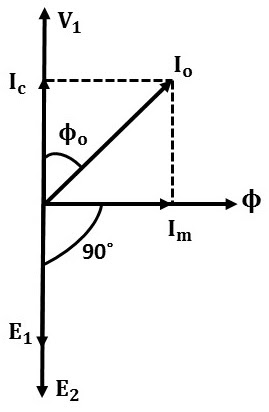Unlocking Transformer Secrets: The No-Load Phasor Diagram Explained
Ever wondered how electricity gets from power plants to your home? Transformers play a crucial role, stepping voltage up and down for efficient transmission and safe usage. A key to understanding their operation lies in the no-load phasor diagram of an ideal transformer. This diagram visually represents the relationship between voltages, currents, and magnetic flux when the transformer's secondary winding isn't connected to any load. It's a fundamental concept for anyone working with electrical power systems.
The ideal transformer, a theoretical concept, forms the foundation for understanding real-world transformers. It assumes no energy losses due to core hysteresis, eddy currents, or winding resistance. While real transformers exhibit these losses, the ideal model provides a simplified starting point for analysis. The no-load phasor diagram specifically depicts the transformer's behavior when no current flows in the secondary winding – a condition crucial for analyzing core losses and magnetizing current.
The concept of the ideal transformer and its associated phasor diagrams emerged with the development of AC power systems in the late 19th century. Pioneers like Nikola Tesla and George Westinghouse recognized the need for efficient voltage conversion and developed the transformer to address this challenge. Understanding the no-load behavior was essential for optimizing transformer design and minimizing losses.
The no-load phasor diagram is pivotal for determining the magnetizing current and core losses of a transformer. The magnetizing current, represented by Im, is the current required to establish the magnetic flux in the transformer core. This current lags the applied voltage by 90 degrees. The core losses, represented by Ic, account for hysteresis and eddy currents within the core material. These losses are in phase with the applied voltage. Analyzing the no-load phasor diagram allows engineers to characterize these parameters and design more efficient transformers.
Understanding transformer behavior under no-load conditions is critical for various reasons. It helps in determining the efficiency of the transformer, predicting its performance under load, and diagnosing potential issues. The no-load phasor diagram acts as a roadmap, illustrating the interaction between voltage, current, and flux. It allows engineers to determine the magnetizing current required to energize the core and identify core losses.
For example, imagine an ideal transformer connected to a 220V AC source on its primary side, with the secondary side open. The no-load phasor diagram would show the primary voltage (Vp) as a reference phasor. The magnetizing current (Im) would lag Vp by 90 degrees. Since it's an ideal transformer, there would be no core loss component (Ic), and the primary current would be equal to the magnetizing current.
One benefit of analyzing the no-load phasor diagram is the accurate determination of core losses, which are crucial for calculating transformer efficiency. Another benefit is predicting the magnetizing current, which aids in sizing the transformer's protective devices. Lastly, it facilitates the understanding of the fundamental principles governing transformer operation.
Advantages and Disadvantages of Ideal Transformer Analysis
| Advantages | Disadvantages |
|---|---|
| Simplified analysis and understanding of basic principles | Does not reflect real-world transformer behavior due to ignored losses |
| Provides a starting point for more complex modeling | Cannot be used directly for accurate performance prediction |
Frequently Asked Questions:
1. What is a phasor diagram? A visual representation of sinusoidal quantities like voltage and current.
2. Why is the ideal transformer a useful concept? It simplifies analysis and provides a foundation for understanding real transformers.
3. What is magnetizing current? The current required to establish the magnetic field in the transformer core.
4. What are core losses? Energy losses due to hysteresis and eddy currents in the transformer core.
5. Why is the no-load condition important? It reveals key parameters like magnetizing current and core losses.
6. How does the no-load phasor diagram help in transformer design? It aids in optimizing core material and winding configurations.
7. What is the significance of flux linkage in a transformer? It determines the voltage induced in the windings.
8. How does the ideal transformer model differ from a real transformer? The ideal model assumes no losses, while real transformers have core losses and winding resistance.
Tips and tricks for understanding no-load phasor diagrams: Remember that in an ideal transformer, the primary flux is equal to the secondary flux. Always consider the 90-degree phase shift between magnetizing current and applied voltage.
In conclusion, the ideal transformer on no-load phasor diagram is a cornerstone of electrical engineering. It provides a simplified yet powerful tool for understanding the fundamental principles governing transformer operation. While real-world transformers exhibit complexities not captured by the ideal model, the no-load phasor diagram serves as an essential starting point for analysis and design. By understanding this diagram, we can unlock the secrets of efficient power transmission and distribution, which power our modern world. Further exploration of transformer theory and practice is encouraged for a deeper understanding of this critical component of electrical power systems. Dive deeper into the fascinating world of transformers and explore the resources available online and in technical literature to expand your knowledge and expertise.
Planning a party in st louis bounce houses steal the show
Protecting your investment shorestation boat lift canopy essentials
Rebel flag cowboy boots a complex cultural icon













